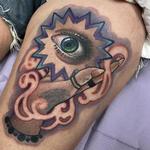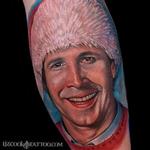PREPARE & AFTERCARE
PREPARE
What you can & should you do in preparation for a tattoo session:
-
Get hydrated. Drink at least one (1) to two (2) liters of water a day. When you are hydrated, your skin is hydrated and will be able to maintain a better heal and withstand longer sessions.
-
Lotion the area to be tattooed every day, or twice daily. Again, the healthier your skin, the better the results.
-
Shave & Exfoliate the area 1-3 times weekly. If you are super hairy, this will really, really make a big difference. It’s hard for lotion to get in there well if you’re Chewbacca. If you experience razor burn, stop shaving a week prior to your appointment. Exfoliation should be gentle with a loofah or basic body scrub.
-
Get a good night sleep the night before. Please don’t party too hard. Getting tattooed hung-over is not fun for you or me.
-
Please EAT BEFORE your session. I can’t tell you how many people I’ve seen pass out just because they were too nervous to eat before. This is a massive workout for your body and IT NEEDS FUEL for a big session. When you are hungry, pain management is much more difficult.
-
Bring drinks, snacks and lunch. You probably won’t have enough time during our short breaks to leave, get food, come back and eat it, so bring it with you! I have a microwave and a fridge at the studio for your convenience. It is also a good idea to bring small snacks that you can eat one handed without making a mess in case you need a distraction during your session. And as a side note, I try to take breaks every 2-3 hours depending on the length of the session.
-
If you happen to break a bone or sustain any other major injuries prior to your appointment, please contact me ASAP.
What you SHOULD NOT DO before a tattoo session:
-
No tanning, fake tanning, chemical peels, sunburns, major cuts or scrapes, in the area to be tattooed within a month prior to your session. I can’t work on freshly damaged skin...it won’t heal properly.
-
No extreme weight lifting in or near the area to be tattooed at least 2 days prior to your session to prevent unnecessary swelling & soreness.
On The Day
-
Please do not bring the entire family or crew unless they are also getting tattooed. Trust me, they get bored or they get in my or other artists’ ways. One person is okay but please be aware that they must wait in the designated waiting areas and must be invited to view ongoing tattoos by myself or other artists.
-
For safety reasons, please do not bring small children or babies.
-
Dress comfortably and appropriately. Be prepared for it to be cold & warm. Also bring socks or flip flops to prevent walking around the studio barefoot during breaks if you will be taking your shoes off during your session.
-
You are also invited to bring your own pillow for laying or sitting on during your tattoo.
-
Bring some form of entertainment for yourself like an IPOD, IPAD, Laptop, portable DVD player, etc. with your own headphones or ear buds.
-
Please do not schedule something immediately after your tattoo...in case we are running behind or long.
-
Please do not use any numbing products on the area to be tattooed and please do not come in under the influence of any drugs or alcohol. For pain, Advil and Tylenol are acceptable during your session.
While You Are Getting Tattooed
-
Please be aware of cross contamination. Do not touch your fresh tattoo during your session. Do not let anyone else touch your tattoo either!
-
Do not touch any of the tattoo equipment or work space.
-
Talking is fine during you session, but please do not talk with your hands, nod your head, or excessively move other body parts as this can cause the area being tattooed to move as well.
-
Be mindful and do not touch any other possibly contaminated areas.
Aftercare
Please consider that everyone heals differently and each tattoo should be given the appropriate attention to aftercare every time. It should not be assumed that all heals will be the same even if you have previously been tattooed! The following aftercare is a general guide for the average heal. However, when necessary, you may have additional steps which will be addressed during your session.
-
Clean your tattoo. Remove the bandage after three (3) hours, but no more than twelve (12). DO NOT remove the bandage until you can properly clean the tattoo with mild soap and warm water. Rinse it well with cold water, thoroughly cleaning off all of the slimy coating that may have formed over the tattooed area while underneath the bandage. Gently pat it dry with a clean paper towel, then allow it to air-dry for ten (10) minutes.
-
Apply healing ointment to the tattoo. Sparingly, but thoroughly, massage a very small amount into the skin to keep the tattoo slightly moist, but NOT smothered. Use just enough ointment to give the tattoo a slightly satin shine, and blot with a clean paper towel. Your skin will take in all the ointment it needs, so do not leave excessive ointment on the skin. For the next three (3) to seven (7) days, clean and apply ointment to your tattoo every six (6) hours, (about 3-4 times daily), blotting the small amount of excess fluid that may be secreted from the tattoo in between cleaning. Ensure that extra moisture doesn’t get trapped under the ointment by blotting and air-drying after every washing. Only apply ointment for as long as it takes for your tattoo to peel or become flakey, usually three (3) to seven (7) days. When the peeling begins, the tattooed skin will flake like a sunburn. AT ALL COSTS avoid picking at the cracked and flaking skin.
-
You are now in the peeling phase. DO NOT apply any more ointment. The area will become dry and itchy, sometimes very itchy. A good quality, fragrance-free lotion (Lubriderm for Sensitive Skin) can now be used three (3) to four (4) times daily INSTEAD of the ointment. Repeat each day until the skin returns to its normal texture.
If you feel a heavier lotion is required to prevent over drying in between application (physically dry to the touch and not just skin that feels tight), you may either apply additional Avocado Oil to the driest areas or switch up to a heavier lotion like Lubriderm for Normal to Dry, or Dry Skin.
If you get any pimples in the area tattooed during this phase, you need to decrease lotion application times or switch down to a lighter or different lotion.
-
Scabs are the body’s natural way of protecting wounds while they are healing. HOWEVER, it is very important to maintain the appropriate aftercare to PREVENT scabs from forming as they can prolong and complicate the healing process which can lead to uneven healing and even scarring.
The first signs that may lead to scabbing often are moisture bubbles that appear during the first few days of a new tattoo, usually caused by negligent cleaning or the over application of ointment. At the first sings of these, clean the tattoo thoroughly and allow to completely dry. Do not waterlog (soak) the tattoo. Only apply ointment sparingly to the areas of the tattoo that do not have bubbles, allowing the bubbles to dry on their own.
If scabs do form, once the tattoo is in the full peeling phase, sparingly apply lotion to the entire area making sure to thoroughly massage and not over apply or soak scabs with lotion. Any developed scabs should not be picked at or prematurely removed.
DIFFICULT & SLIMY HEALS
-
Clean your tattoo as explained in the previous section.
-
When the tattoo is dry to the touch, cover it completely with a new piece of plastic wrap, using tape as needed to hold it in place. Do not use any healing ointment or moisturizer.
-
For the next one (1) to three (3) days, the tattoo is kept completely covered with plastic wrap, 24 hours a day. It is crucially important to wash the tattoo every four (4) to six (6) hours, except at night for a maximum of 8 hours, or after any period of sweating. Let it completely air dry after washing. Apply a new piece of plastic wrap each time. After the tattoo no longer forms a slimy coating underneath the wrap, and just body moisture is left, it is okay to cease wrapping and switch to applying ointment.
-
It is also important not to over-wrap the area as covering large areas of untattooed skin can trap excess moisture. Too much plastic wrap on the surrounding skin - or not changing the wrap often enough - can lead to MOISTURE RASH. This will appear as bright red irritation with tiny pimples in the affected area, and will likely feel painful and itchy. If this happens, ice the area for no longer than 20 minutes at a time while it is covered with the wrap. If this does not relieve the pain or itching, unwrap the area, clean and let it completely dry, switching to using ointment ONLY on the tattooed area.
WHAT YOU SHOULD NOT DO AFTER A TATTOO SESSION
-
The healing tattoo should never be submerged or soaked in water. You should also avoid saunas or other steamy and sweaty environments until the tattoo has finished flaking and peeling. Therefore, limit yourself to only short showers that DO NOT allow steam to build up on bathroom mirrors.
-
Do not swim until the flaking and peeling is all gone naturally by itself. Usually this takes around two (2) to three (3) weeks. The Texas health department lists that there should be at least a two (2) week waiting period.
-
While your tattoo is healing, do not allow it to be exposed to sun or other forms of UVA/UVB radiation including tanning beds. This significantly increases your risk of scaring as the tattooed area is still an open wound. Also be aware that there is an increased risk to skin cancer as the skin is highly vulnerable in any healing condition.
Refrain from any workout or physical activity heavier than walking, especially in cases where the new tattoo is in a direct sweat zone of the body. It is also important that a fresh tattoo be kept out of the sun and dirty environments, as it is still an open wound. ?
WHAT YOU SHOULD DO AFTER A TATTOO SESSION
-
After all flaking and peeling is gone, normal activities in water can be resumed.
-
The use of sunblock on the tattooed area may be resumed after all the flaking and peeling is gone. When in the sun or swimming, it is vital to apply and allow to dry, a sunblock of at least 60 SPF every two (2) hours as listed by FDA regulations. Please be aware that sunblocks of 100 SPF and higher are available. Sun burning will permanently damage and fade your healed tattoo.
-
Intentionally tanning your skin will make tattoos look dingy. If you must tan, use a minimum of 60 SPF on your tattoos even if you choose to use other methods for the rest of your non-tattooed skin.
-
After all flaking and peeling is gone, light to moderate cardio may be resumed. However, muscle specific training involving the tattooed area may be resumed when the collagen returns to the area. This takes roughly three (3) to four (4) weeks to allow for complete return of elasticity to the skin.
-
Daily moisturizing and staying hydrated (8 glasses of water a day – 64 fl. oz. or 2 liters) keeps the skin healthy which inevitably keeps the tattoo looking good. The healthier the skin, the better the tattoo will look. Exfoliating and/or shaving/trimming the hair on the tattoo can also keep the tattoo looking better.
|
|








